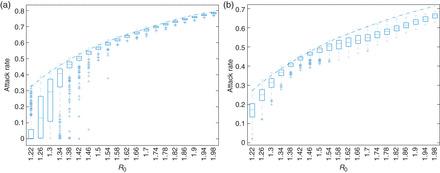Fig. 1.

The distribution of attack rates (all cumulative infections, clinical or otherwise) as a function of transmissibility (R0). Each box plot shows the range of outcomes from the set of simulations, with the bar indicating the median, boxes covering the inter-quartile range, whiskers extending to the adjacent values and crosses indicating outliers. The dash-dotted line indicates the median attack rate over all simulations in the absence of intervention. Note that a strain-specific vaccine is rolled out to the population at Week 18 of the simulation, providing definitive control. (a) A targeted antiviral intervention, providing treatment to identified cases and post-exposure prophylaxis to contacts of identified cases. For high R0 (>1.5), the box plots are tightly constrained (i.e. all simulations give roughly the same result) and overlap with the baseline (no intervention) median result. For low R0 (<1.25), the intervention is expected to significantly reduce the attack rate. For intermediate values of R0, between 1.25 and 1.5 the intervention may reduce the attack rate—the broad inter-quartile range, and significant tail of outliers extending towards very low attack rates indicates that the utility of the intervention is highly dependent upon other model parameters that are sampled in the scenarios. (b) A school-based measure (reduced child–child mixing) implemented for 12 weeks from the initiation of transmission under the baseline assumption that child–child mixing is enhanced compared with adult–adult mixing. The intervention's effect is less substantial than in (a), and unable to completely control the epidemic. However, it is maintained over the broad range of R0 values considered. The relative reduction in intervention success for intermediate values of R0 is a complex result of the interplay between the timing of exponential growth, intervention withdrawal (at 12 weeks) and vaccine introduction (at 18 weeks), and is explored in detail in the Supplementary data.
